
Learn about EPA's work to protect and manage water resources and what you can do to help.
- Subject:
- Science
- Material Type:
- Reading
- Provider:
- United States Environmental Protection Agency
- Date Added:
- 08/28/2023

Learn about EPA's work to protect and manage water resources and what you can do to help.

A discussion of Thomas Campion's literary criticism from the Elizabethan period. From the Cambridge History of English and American Literature.
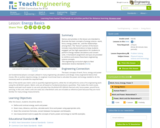
Demos and activities in this lesson are intended to illustrate the basic concepts of energy science -- work, force, energy, power etc. and the relationships among them. The "lecture" portion of the lesson includes many demonstrations to keep students engaged, yet has high expectations for the students to perform energy related calculations and convert units as required. A homework assignment and quiz are used to reinforce and assess these basic engineering science concepts.
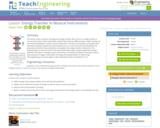
This lesson covers concepts of energy and energy transfer utilizing energy transfer in musical instruments as an example. More specifically, the lesson explains the two different ways in which energy can be transferred between a system and its environment. The law of conservation of energy will also be taught. Example systems will be presented to students (two cars on a track and a tennis ball falling to the ground) and students will be asked to make predictions and explain the energy transfer mechanisms. The engineering focus comes in clearly in the associated activity when students are asked to apply the fundamental concepts of the lesson to design a musical instrument. The systems analyzed in the lesson should help a great deal in terms of discussing how to apply conservation of energy and energy transfer to make things.

This site is from the Physics Department at Georgia State University. The reliance upon the law of conservation of energy as an approach to problem-solving is presented and encouraged. It is modeled through a problem involving a free-falling object.
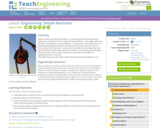
Simple machines are devices with few or no moving parts that make work easier. Students are introduced to the six types of simple machines the wedge, wheel and axle, lever, inclined plane, screw, and pulley in the context of the construction of a pyramid, gaining high-level insights into tools that have been used since ancient times and are still in use today. In two hands-on activities, students begin their own pyramid design by performing materials calculations, and evaluating and selecting a construction site. The six simple machines are examined in more depth in subsequent lessons in this unit.
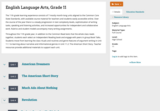
The 11th grade learning experience consists of 7 mostly month-long units aligned to the Common Core State Standards, with available course material for teachers and students easily accessible online. Over the course of the year there is a steady progression in text complexity levels, sophistication of writing tasks, speaking and listening activities, and increased opportunities for independent and collaborative work. Rubrics and student models accompany many writing assignments.Throughout the 11th grade year, in addition to the Common Read texts that the whole class reads together, students each select an Independent Reading book and engage with peers in group Book Talks. Students move from learning the class rituals and routines and genre features of argument writing in Unit 11.1 to learning about narrative and informational genres in Unit 11.2: The American Short Story. Teacher resources provide additional materials to support each unit.

In this unit, students will take a look at the historical vision of the American Dream as put together by our Founding Fathers. They will be asked: How, if at all, has this dream changed? Is this dream your dream? First students will participate in an American Dream Convention, acting as a particular historical figure arguing for his or her vision of the American Dream, and then they will write an argument laying out and defending their personal view of what the American Dream should be.
ACCOMPLISHMENTS
Students read and annotate closely one of the documents that they feel expresses the American Dream.
Students participate in an American Dream Convention, acting as a particular historical figure arguing his or her vision of the American Dream.
Students write a paper, taking into consideration the different points of view in the documents read, answering the question “What is the American Dream now?”
Students write their own argument describing and defending their vision of what the American Dream should be.
GUIDING QUESTIONS
These questions are a guide to stimulate thinking, discussion, and writing on the themes and ideas in the unit. For complete and thoughtful answers and for meaningful discussions, students must use evidence based on careful reading of the texts.
What has been the historical vision of the American Dream?
What should the American Dream be? (What should we as individuals and as a nation aspire to?)
How would women, former slaves, and other disenfranchised groups living during the time these documents were written respond to them?
BENCHMARK ASSESSMENT: Cold Read
During this unit, on a day of your choosing, we recommend you administer a Cold Read to assess students’ reading comprehension. For this assessment, students read a text they have never seen before and then respond to multiple-choice and constructed-response questions. The assessment is not included in this course materials.

In this lesson, students will take their group's feedback into account and revise their final paper.

This site contains links to texts of many works by Richard Lovelace. "The world will have forgotten all the great masterpieces of literature when it forgets Lovelace's three verses to Lucasta on his going to the wars." --Thomas Aldrich
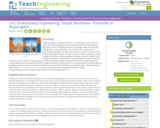
Simple machines are devices with few or no moving parts that make work easier, and which people have used to provide mechanical advantage for thousands of years. Students learn about the wedge, wheel and axle, lever, inclined plane, screw and pulley in the context of the construction of a pyramid, gaining insights into tools that have been used since ancient times and are still important today. Through numerous hands-on activities, students imagine themselves as ancient engineers building a pyramid. Student teams evaluate and select a construction site, design a pyramid, perform materials calculations, test a variety of cutting wedges on different materials, design a small-scale cart/lever transport system to convey building materials, experiment with the angle of inclination and pull force on an inclined plane, see how a pulley can change the direction of force, and learn the differences between fixed, movable and combined pulleys. While learning the steps of the engineering design process, students practice teamwork, creativity and problem solving.

A narrated tutorial which illustrates how the work-energy theorem can be expanded to include other kinds of energy. [10:07]

Students drop water from different heights to demonstrate the conversion of water's potential energy to kinetic energy. They see how varying the height from which water is dropped affects the splash size. They follow good experiment protocol, take measurements, calculate averages and graph results. In seeing how falling water can be used to do work, they also learn how this energy transformation figures into the engineering design and construction of hydroelectric power plants, dams and reservoirs.

This video provides insight on the human protein. Content explores what a protein is, how they work, and how they are made.
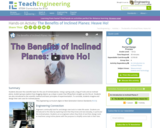
Students discover the scientific basis for the use of inclined planes. Using a spring scale, a bag of rocks and an inclined plane, student groups explore how dragging objects up a slope is easier than lifting them straight up into the air. Also, students are introduced to the scientific method and basic principles of experimentation. To conclude, students imagine and design their own uses for inclined planes.

This site contains the full text of Sir Arthur Conan Doyle's Sherlock Holmes mystery "The Hound of the Baskervilles." Includes a summary note.
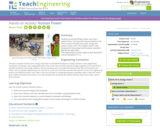
Students do work by lifting a known mass over a period of time. The mass and measured distance and time is used to calculate force, work, energy and power in metric units. The students' power is then compared to horse power and the power required to light 60-watt light bulbs.
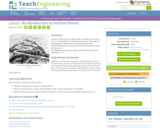
Students are introduced to the concept of simple tools and how they can make difficult or impossible tasks easier. They begin by investigating the properties of inclined planes and how implementing them can reduce the force necessary to lift objects off the ground.

Watch this screencast to understand the work-energy theorem in regards to energy. [8:45]

A video lecture defining working and energy and by giving types of work we can do and what type of energy transferring to an object when doing that work. Understand how work and energy are related. [9:17]
Khan Academy learning modules include a Community space where users can ask questions and seek help from community members. Educators should consult with their Technology administrators to determine the use of Khan Academy learning modules in their classroom. Please review materials from external sites before sharing with students.